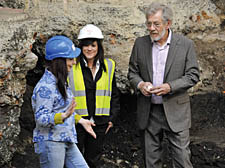|
|
 |
| |

Sir Ian McKellen, the Museum of London’s Taryn Nixon (centre) and archeologist Heather Knight at the dig. Picture: Museum of London Archaeology |
Am-dram society with its own place in theatre history
Company plans new arts hub at long-lost site where Romeo and Juliet was first performed
IT’S like something from a theatre lover’s wildest fantasy.
The Tower Theatre Company, an amateur dramatics society based for decades at Canonbury Tower, found a site for a new home just across the border in Hackney when it lost its Canonbury base in a legal dispute eight years ago.
It commissioned an archaeological survey of the site at New Inn Broadway, near Old Street, occupied by a derelict warehouse. And earlier this year it made a surprise discovery: the Holy Grail of British theatre.
Under the warehouse was part of an Elizabethan auditorium known simply as The Theatre, the well-documented but long-lost stage where Romeo and Juliet was first performed and where the Bard cut his teeth as an actor.
Though the discoveries were reported at the time, they were downplayed by the Tower Theatre Company, which feared a rush of Shakespeare lovers. But now the company, which was granted planning permission two weeks ago to build a £7million, 135-seat auditorium on the site, has detailed its plans for what it hopes will become a focus for local theatre.
Chairwoman Penny Tuerk said the company wanted to display the amazing archeological finds, which include part of The Theatre’s inner wall and the gravel on which the star-crossed lovers first kissed.
Mrs Tuerk said: “After the discoveries were made, Sir Ian McKellen came to look at them. It sounds extraordinary because it’s a bit of compacted gravel, but it’s actually where people stood to watch the first performance of Romeo and Juliet.
“If we can agree with English Heritage on a way of displaying them that’s not going to degrade them, we hope to display the finds. We’re talking to experts but my understanding is that we could stabilise them, and then one has to deal with the issue of humidity in the ground, so they could be displayed behind Perspex or glass.”
Along with English Heritage, Museum of London archaeologists are caring for items found during digs at the site. These have recently included rare pieces of 16th century pottery.
Mrs Tuerk said: “The Theatre was the first public theatre in London. Shoreditch is a new hub for people working in the arts but there is a great need for an accessible, smaller scale theatre there.”
Because of Elizabethan legal records, archaeologists had known The Theatre was in Shoreditch but not exactly where it was until they started carrying out excavations at New Inn Broadway. During Shakespeare’s day, Shoreditch was just outside the City of London – at that time controlled by the clergy, who had outlawed dramatic performance.
The Tower Theatre Company is working to raise, through donations, the remaining £3.3million it needs to build its new base.
It will reach a decision as to whether to put the fragments from The Theatre on public display after spring next year, by which time archaeologists from the Museum of London will have completed excavations they hope will yield further discoveries. |
 |
|
|
 |
| |
| |
|
 |
|